Adobe Creative Cloud Updates
On 11/10/2017 OSU IT informed us of the new Adobe licensing agreement. This information stated that Adobe licensing on our work computers would expire on November 30th, 2017.
How does this effect you? After the end of this month, our Adobe software (Photoshop, InDesign, Illustrator, Acrobat etc.) will cease to function until the Adobe Creative Cloud app has been installed AND you have logged into the Creative Cloud as an enterprise user (using your OSU/OKEY Email address and password).
Please contact your Support Specialist if you have any questions or issues updating your Adobe software.
Central IT’s announcement can be found at: https://app.it.okstate.edu/itannounce/index.php/module/FullStory/action/FullStory?id=13962&From=Home
A complete step by step guide can be found at: http://support.dasnr.okstate.edu/reference-materials/adobe-products/Adobe%20Creative%20Cloud%20install%20and%20troubleshooting%20guide.pdf
P@55w0rdS! – Cyber Security Awareness Month 2017
Creating secure passwords is critical to protecting your online accounts, your personal data, and your identity. October is National Cyber Security Awareness Month, and it is a perfect time to review your passwords!
Through websites and smartphone apps we shop, read email and scan social media sites, review credit card transactions, and check bank accounts. In the process, we create and maintain a number of passwords. Today’s news of companies whose databases of stored passwords are compromised quickly reminds us: no password is unimportant!
We are encouraged to create secure passwords, but what constitutes a secure password? According to Google strong passwords contain a mix of letters, numbers and symbols. “An eight-character password with numbers, symbols and mixed-case letters is harder to guess because it has 30,000 times as many possible combinations than an eight-character password with only lower case letters.”[1] But it may be a challenge to remember each unique password! If you create password from a mix of random characters, you may find yourself writing them down to ensure you don’t forget it. StaySafeOnline[2] recommends to “focus on sentences or phrases that you like to think about and are easy to remember.” I like to choose lyrics of favorite songs. For example, using the OSU Alma Mater I might choose the first letter of the opening lyrics: Proud And Immortal Bright Shines Your Name. So it would look like ‘paibsyn.’ Then I would adjust it to include some capitalized letters, a number and symbol. Such as “Pa!bsyN2017”. Keep in mind, when adding a number to your password, it is recommended to avoid using a number of importance such as an anniversary or birthday.
Another recommended practice for securing your accounts and your passwords is to enable two-factor authentication which adds a layer to your login process. Many sites, such as Google, Apple and credit card companies, now use this feature either as an option or as a mandatory practice. For example if I log into my Gmail account from a new device, I receive a text message with a code I must enter before I can access my email. This helps prevent hackers from accessing your account as it is one more step to access your personal data.[3]
Following these practices to maintain secure passwords may not prevent your personal information from being compromised, but it will make it harder for cyber criminals. Your online security should always be a priority. It’s far easier to protect yourself now then after your data has been compromised.
[1] https://support.google.com/accounts/answer/32040?hl=en
[2] https://staysafeonline.org/cybersecure-business/protect/
[3] https://www.dhs.gov/blog/2015/10/13/staying-protected-while-always-connected
Can OneDrive be used as a Backup Tool?
Can OneDrive be used as a Backup Tool?
Sometimes I feel like a broken record talking about backups! But it is so vitally important to safeguard your data, I feel it is necessary to mention it as often as possible. We talk about using tools like CrashPlan and external hard drives, but with budgets the way they are in many places, access to a free backup option is often requested. For this post, I’m going to talk about using Microsoft OneDrive as a backup tool for our most important files and folders!
As an OSU employee, we have access to Office 365 features, which include online web apps for quick edits of Word, PowerPoint and Excel documents. There are also mobile apps for our smart phones and tablets. In addition, our Office 365 accounts give us access to 1TB of cloud data storage using OneDrive for Business, which is plenty of storage to back-up your files, especially your most important files! (See the links below to access information about setting up OneDrive for Business)
While OneDrive seems like the answer to all of our backup needs, there a few “challenges”. One of these problems is there isn’t a way to easily backup your entire computer to OneDrive. Instead, OneDrive acts as a computer folder such as “Documents” or “Pictures.” This means, in order to back something up, you have to manually save the file to OneDrive, or drag and drop the existing folder into OneDrive for Business. In other words, the file isn’t saved in your My Documents folder but instead it’s saved to the cloud. However, if you have OneDrive for Business installed on your computer, a local copy may be downloaded to your computer.
Another challenge involves the required 120 day OKEY password change we are required to perform. On occasion, I’ve run into issues with OneDrive for Business syncing following my OKEY password change. This can be frustrating and takes a little time to resolve.
Finally, it needs to be noted that OneDrive and OneDrive for Business are NOT the same thing. OneDrive for Business is associated with the OSU Office 365 agreement and is where you may find your files. But with Office installs, the regular OneDrive is automatically installed. Unfortunately, it will not work with your OKEY credentials so you will need to set up OneDrive for Business to use the full benefits that we have access to as OSU employees .
Overall, OneDrive for Business is a great tool, especially for collaboration, cloud access and even backing up some data. However, at this time, it is a manual backup, and cannot be set up as an auto backup option for your computer.
For more information regarding Office 365 and setting up OneDrive for Business on your computer check out these blog posts or contact your Support Specialist for assistance.
Purchasing a Computer for the New School Year
As the summer is winding down and the beginning of a school year is rapidly approaching, we are receiving a lot of questions about purchasing new computers. For 4H Roundup, I put together a presentation, which covered what to look for in a new computer, and I thought it might be useful to share some of these concepts in a short blog post. I hope these ideas help!
Buying a new computer can be overwhelming! With so many options on the market, it’s hard to narrow down what will be best for your individual needs. The first thing you should consider is what the computer is going to be used. For this purpose, let’s stick with a computer that you will use for school. Most likely, this will narrow us down to a portable laptop.
One would think this would narrow down the possibilities, but alas, the next decision you have to make is what KIND of laptop. Considerations here include, weight, size, functionality. If you are “tossing” your laptop into your bag every day to take notes in class, you may want to consider a lightweight, smaller option. Perhaps an 11” or 13” laptop would be a nice option for you. The primary drawback with a small laptop is the screen size. A small screen size can make writing large papers, doing extensive research or major projects difficult. If a small portable laptop is still a priority and you find yourself needing a larger screen, a great solution is to purchase a secondary monitor for your home workstation. A docking station may allow for flexibility for attaching your laptop to the monitor as well.
If a tablet is something you are interested in but you also want a device with a little more power, a 2-in-1 is another great option. A 2-in-1 gives you the flexibility of a tablet as the screen folds over into a flat device but also the functionality of a laptop with a full keyboard. There a several 2-in-1 options ranging from the Dell Inspiron and XPS lines to the Windows Surface Pro.
Once you’ve figured out what to buy, make sure to consider specs. Often we will see “great sales” on laptops this time of year, but in many cases, there is a reason the device is so cheap. If you are aiming for a laptop to last several years, make sure you get a minimum of an Intel i5 processor, 8 to 16 GB of memory (RAM) and a hard drive with plenty of storage OR a solid state hard drive. *Note, a solid state hard drive (SSD) do not offer a large amount of storage space and can cost a good deal more compared to a 1TB SATA drive. Your speed or storage needs will affect the decision of what kind of hard drive you should purchase.
I hope some of this information helps you make a successful purchase for the upcoming school year!
~Cynthia
7/31/2017
Adobe Connect and Mobility: Q&A
Adobe Connect has become a primary webinar tool for DASNR and Extension personnel at OSU. Adobe Connect is ideal for monthly in-services, remote meetings and small meetings. As travel budgets are lessening, Adobe Connect allows people to attend and participate, regardless of location. All they need is an Internet connection. However, you do not need to be in front of a computer to attend an Adobe Connect meeting. Android and Apple phones and tablets have abilities that let users attend Adobe Connect sessions from anywhere, even on the road. Below are a few Q&A’s to help answer how you can use your mobile phone to attend, and participate in an Adobe Connect session.
Q: Can I attend an Adobe Connect Session if I am not at my computer?

A: Yes! You can attend an Adobe Connect session from your Smart Phone or Tablet. Android and Apple both have Adobe Connect apps and as long as there is a network or cell signal, you can attend the session. Most tablets require use of a Wi-Fi connection unless your tablet has LTE cellular service enabled. Please note: attending a Connect session on your phone will use some data so if you do not have a limited data plan, this may not be a great solution unless Wi-Fi is available.
Q: Can I present from my mobile device?
A: Again, yes! Presenting from a mobile device simply requires the installation of the Adobe Connect App, and enabling the microphone on your phone (or use a set of headphones with a mic) and either a Wi-Fi or cellular connection. The Apple headphones are great examples of headphones with a mic (http://apple.co/2pJEVw5) but there are many other great options out there as well. It is recommended for presenters to try out this feature before the day of the session to ensure ease of use and familiarity as the app interface is slightly different from the computer version. It is also recommended that the presentation documents (PowerPoint or PDF) is pre-loaded from your computer or ask someone to load it for you as it may not be a smooth and easy process to add from your mobile device.
Q: Can I watch a recorded Adobe Connect session from my mobile device?
A: Unfortunately, the answer on this is no. A problem with Adobe Connect is it requires Adobe Flash to play recordings and neither Android nor Apple tablets/phones have this ability. That said, if you are a fortunate owner of a Windows Surface Pro or any tablet running a Windows operating system, you are able to view recordings.
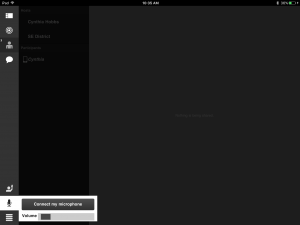
Adobe Connect mobile view for iPad
Q: Will I be able to speak using my mobile device if I am a participant?
A: Yes. The process works the same as if you are on your computer. The host or presenters have to give mic permissions and then you have to enable your mic from your device. Once the host has given the permissions, a mic symbol should appear (look in the lower left corner) and then you can tap the symbol and enable the mic.
Adobe Connect is a great and versatile tool and I hope this short post helps to provide some functionalities and ideas for your future connect sessions. If you are interested in setting up an Adobe Connect session or using a mobile device to attend or present, contact your support specialist and they will be happy to help you get it set up.
Is This Email Real?
Is this email real?
As tech support specialists, we receive this question regularly. But there are ways for you to determine if an email is a phishing attempt or spam. In light of recent phishing email attempts to all of us at OSU, here are some things to consider when deciding the legitimacy of an email.
By now, we have all probably received something similar to this email. It looks real. Even looking up the sender in the OSU system, provides you with information that this person is a student at OSU with an OSU email address. However, there are several red flags with this email indicating this person’s email account has been hacked. First, consider, why would a student be sending an email for HR? But what if an HR person’s email has been hacked?
OSU system, provides you with information that this person is a student at OSU with an OSU email address. However, there are several red flags with this email indicating this person’s email account has been hacked. First, consider, why would a student be sending an email for HR? But what if an HR person’s email has been hacked?
Another hint toward the genuineness of this email can be found when hovering over the “Click here” (NOTE, DO NOT CLICK! Simply hover your mouse over it). Notice the URL that appears when your mouse is hovering over the link. The first part is http://www.vertiusmc.eu, which already indicates that this email is not actually coming from OSU, nor is it something recognizable. Also, as a general rule of thumb, OSU will not ask you to “click” on something to log in to the system. As another general rule of thumb, you should never follow a link that says “Click here” or “Click on this link” unless you are 100% positive of the site you are being directed to. Hovering over the link will help tell you where the link is directing you too.  Also, if it is a familiar site to you already, simply go to it instead of using an email link. For example, you have received an email to change your password. We know that to change our OSU password, we need to go to Okey.okstate.edu. So instead of clicking the link in the email, open a browser and type the URL in.
Also, if it is a familiar site to you already, simply go to it instead of using an email link. For example, you have received an email to change your password. We know that to change our OSU password, we need to go to Okey.okstate.edu. So instead of clicking the link in the email, open a browser and type the URL in.
As always, if you are unsure, check your support person. They can help you determine if the email is reputable or a SPAM attempt.
Here a few quick checklist items to consider when determining a SPAM or Phishing attempt, provided by OSU Security:
- Do not trust the display name of whom the email is from. Just because it says it’s coming from a name of a person you know or trust doesn’t mean that it truly is. Be sure to look at the email address to confirm the true sender.
- Look but do not click. Hover or mouse over parts of the email without clicking on anything. If the alt text looks strange or does not match what the link description says, do not click on it – report it to abuse@okstate.edu.
- Beware of urgency. These emails might try to make it sound as if there is some sort of emergency.
- Do not believe everything you see. When in doubt, have it checked out. If something seems slightly out of the norm, it’s better to be safe than sorry. If you see something off, then it’s best to report it to abuse@okstate.edu and have it checked out.
Outlook Credentials
Over the past few weeks, I have received many calls about why Microsoft Outlook has stopped requiring our email addresses and OKEY passwords to be entered when we start our computers in the morning. After some investigating, here is what I’ve learned on the subject.
Recently, Microsoft changed how we access our email accounts in Outlook. Previously, when we opened Outlook first thing in the morning we were required to put in our credentials. Now, unless you change your password, this is no longer required, nor is it an option. This is because Microsoft felt that we should be logging into our computers after being away and that was authentication enough. After making a phone call to the Helpdesk on campus, I unfortunately learned, this is a permanent change and not something we have any control over. While I requested we have the ability to choose this setting, it may be several months before the change can be made, if at all. So what can we do to protect our email accounts? Below are a couple solutions for you to consider.
First, having a secure user password to log onto your computer that is unique to you (not the office) is highly recommended. This prevents anyone from walking up to your computer and accessing your files, emails, settings, or any other part of your computer you may not want others to access. If the reason you have a shared office password on your computer is for file access, we advise you consider setting up a file sharing system. This would allow co-workers on your network to access the files you give permission for while protecting your programs and other materials such as your email. Having multiple user accounts or guest accounts on your computer can also help minimize other people accessing your files and email.
The second option is to use remove your Outlook configuration from your computer all together and only use cowboymail.okstate.edu which you would access via your web browser (contact your support specialist for removal assistance). This has a couple pros to it. The webmail app requires you to enter your password anytime you check your email therefore allowing your email to stay secure from other users that may need on your computer. In addition, it has all of the functionality of the Outlook program without the headaches of downloading files. In addition, the webmail app does not log you out as it used to. You can open your web browser in the morning, open your email and then leave it open all day for easy access. Simply closing the browser will disconnect your email log in, preventing someone from accessing your personal emails.
I know this isn’t the answer many of you were looking for, but for now, these are the best and most secure options we can offer. If you would like assistance in setting up passwords, file sharing or accessing cowboymail.okstate.edu, please do not hesitate to contact your support specialist. We are here to help!
Web Conference Tools
Over the last few years, webinars seem to have taken over as a favorite communication method. Whether using Zoom, Adobe Connect, or even Skype for Business, having good technology will help ensure these sessions run smoothly and you have the best experience possible! Here are a few great webinar tech options.
The first and most important items are microphones and speakers. We recommend combining this into a headset with mic so you can focus on connecting one device instead of two. A great headset option, and one that I use, is the Logitech USB Headset. This headset connects to your computer via your USB port. It is comfortable to wear and set up is easy with plug and play installation. They are also affordable at around $30 a set.
We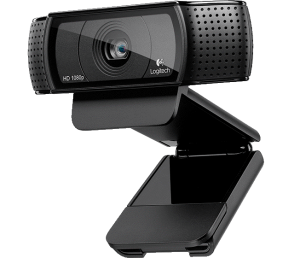 bcams are also useful to have especially in Zoom web meetings. There are many great webcams on the market to choose from. According to Wirecutter.com, a popular website for rating technology tools, the Logitech HD C920 is the best option for your money. It has excellent screen resolution, built in mic, automatic noise reduction, and fast autofocus. This webcam will cost about $100 (sales have been found putting this webcam in the $75 range, so don’t rule it out until you price check this one!)
bcams are also useful to have especially in Zoom web meetings. There are many great webcams on the market to choose from. According to Wirecutter.com, a popular website for rating technology tools, the Logitech HD C920 is the best option for your money. It has excellent screen resolution, built in mic, automatic noise reduction, and fast autofocus. This webcam will cost about $100 (sales have been found putting this webcam in the $75 range, so don’t rule it out until you price check this one!)
If $100 is too high, the Logitech C615 ($70) and C525 ($60) are also great webcam options. While you do sacrifice some quality of picture with these models, they both have the same plug and play ease as the C920. The C615 is also a great portable option as the clip stand folds around the camera and protects the lens during travel.


For offices with conference rooms that may host a web meeting from time to time, the Logitech BCC950 conference camera is a great option.  It has an adjustable webcam (an extender comes with the product), built in speakerphone, and built in microphone. While a little pricey, at $250, the attendees will be able to communicate clearly with the presenters while providing a clear picture of the room where they are.
It has an adjustable webcam (an extender comes with the product), built in speakerphone, and built in microphone. While a little pricey, at $250, the attendees will be able to communicate clearly with the presenters while providing a clear picture of the room where they are.
Automatically Connecting to Public Networks
It seems everywhere we go, free wireless networks seem to exist. From our favorite local coffee shop, to the McDonalds down the street and even in the parking lots of a doctor’s office. While these public networks seem great, especially for those of us with limited data plans on our smartphones, we have to remember these networks are not secure and can be easily compromised. Even more worrisome, your phone or computer might be automatically connecting to these networks.
I ran into such a situation the other day. I was a little early for a doctor’s appointment and had my laptop with me so I thought I would catch up on some notes. When I turned on my laptop, I noticed I had connected to a network. This concerned me because there was no reason my laptop would have access to this network. I opened my network settings to try to get to the bottom of why it just “connected” to this unknown network. As I went through trying to decipher what network settings were enabled, I came across “W-Fi Sense”. In the description, above the On/Off radio button, it stated“Connect to suggested open hotspots”. I immediately disabled this setting because I want to be in control of networks my computer connects too.
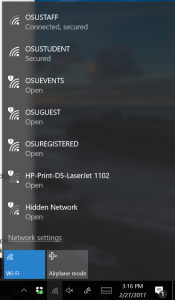
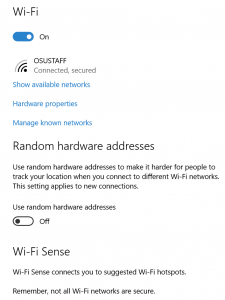
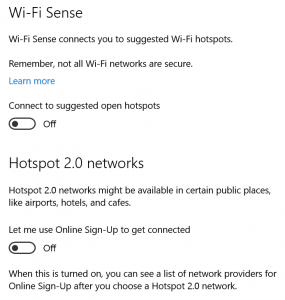
Personal computers are not the only devices that can auto connect to a network. Androids and iPhones/iPads also have the ability to auto connect to hotspots. I recommend disabling these features on those devices as well.
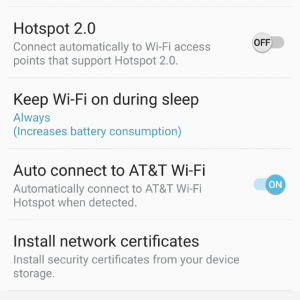
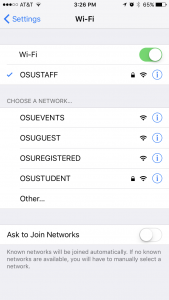
As always, if you have a question or concern, contact your support specialist
~Cynthia Hobbs
A “New” MS Word Tool
I learned of a new Microsoft Office tool the other day!
I am taking an online class that focuses on business computer concepts and applications. In the class, I get to work my way through various Office modules. I will be honest, it can be a bit tedious, BUT I have already found a handful of new tricks. Perhaps, some of them I knew and had forgotten over time. However, this one was new for me so I thought I would share.
Do you have certain words you struggle to spell? For me, it does not matter what I do, I cannot spell the word ‘inconvenience’. Well, the trick I learned will help me with this struggle as I can add my spelling for the word to the Proofing option and anytime I spell inconvenience wrong, it will automatically correct it.
To adjust this setting simply click on File and go to Options.

Then select ‘Proofing’ followed by “AutoCorrect Options…”
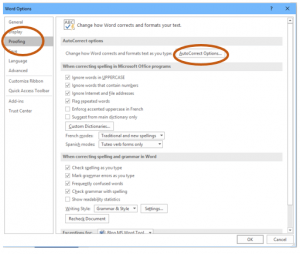
Finally, type the how you usually spell your word you struggle with under ‘Replace’ and ‘With’ and now anytime you mistype this word, it will automatically replace the text as you type! Personally, I think this is a pretty neat tool!
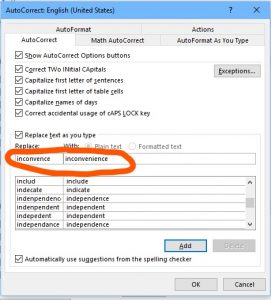
Check back over the next semester and I’ll add more little tips and tricks I pick up along the way!
~Cynthia